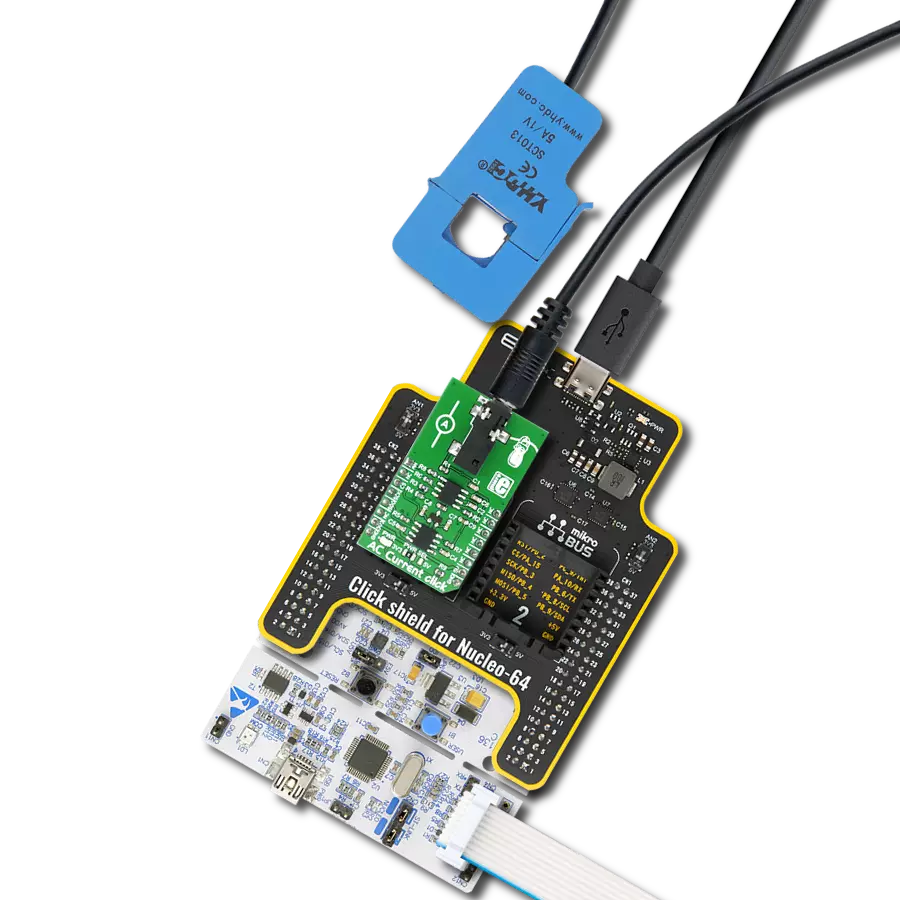通过利用我们的霍尔效应电流传感解决方案,最大限度地延长设备的寿命,该解决方案有助于识别过载条件并防止潜在的损坏。
A
A
硬件概览
它是如何工作的?
Hall Current 10 Click基于Broadcom Limited的ACHS-7194,这是一款霍尔效应电流传感器,它发送与通过主输入导体的电流引起的磁场强度成正比的模拟电压。在没有磁场的情况下,输出电压为供电电压的一半。ACHS-7194可以检测直流和交流,设计用于±40A的电流范围。通过将磁信号与霍尔传感器的近距离接触,优化了设备在操作环境温度下的准确性。铜导体的厚度使得设备能够在高过电流条件下生存。导电路径的端子与信号引线电气隔离。这个特性使得
ACHS-7194能够在不需要光耦或其他昂贵的隔离技术的应用中使用。ACHS-7194还具有比率输出,它与供电电压成比例地变化。类似于这样,输出电压,模拟信号,可以使用Microchip的MCP3221转换为数字值,MCP3221是一款具有12位分辨率的逐次逼近A/D转换器,使用2线I2C兼容接口,或者可以直接发送到标记为AN的mikroBUS™插座的模拟引脚。选择可以通过标记为ADC SEL的板上SMD跳线到适当的位置标记为AN和I2C来执行。使用
MCP3221,在标准模式下以最高100kbit/s的速率传输数据,在快速模式下以最高400kbit/s的速率传输数据。此外,在连续转换模式下,MCP3221可以以最大22.3kSPS的样本速率与400kHz的时钟速率进行可能的转换。这个Click板™可以通过VIO SEL跳线选择3.3V或5V逻辑电压电平进行操作。这样,既支持3.3V又支持5V的MCU可以正确使用通信线路。此外,这个Click板™配备了一个包含易于使用的函数和示例代码的库,可用作进一步开发的参考。

功能概述
开发板
PIC32MZ Clicker 是一款紧凑型入门开发板,它将 Click 板™的灵活性带给您喜爱的微控制器,使其成为实现您想法的完美入门套件。它配备了一款板载 32 位带有浮点单元的 Microchip PIC32MZ 微控制器,一个 USB 连接器,LED 指示灯,按钮,一个 mikroProg 连接器,以及一个用于与外部电子设备接口的头部。得益于其紧凑的设计和清晰易识别的丝网标记,它提供了流畅且沉浸式的工作体验,允许在任
何情况下、任何地方都能访问。PIC32MZ Clicker 开 发套件的每个部分都包含了使同一板块运行最高效的必要组件。除了可以选择 PIC32MZ Clicker 的编程方式,使用 USB HID mikroBootloader 或通过外部 mikroProg 连接器为 PIC,dsPIC 或 PIC32 编程外,Clicker 板还包括一个干净且调节过的开发套件电源供应模块。USB Micro-B 连接可以提供多达 500mA 的电流,这足以操作所有板载和附加模块。所有
mikroBUS™ 本身支持的通信方法都在这块板上,包 括已经建立良好的 mikroBUS™ 插槽、重置按钮以及若干按钮和 LED 指示灯。PIC32MZ Clicker 是 Mikroe 生态系统的一个组成部分,允许您在几分钟内创建新的应用程序。它由 Mikroe 软件工具原生支持,得益于大量不同的 Click 板™(超过一千块板),其数量每天都在增长,它涵盖了原型制作的许多方面。
微控制器概述
MCU卡片 / MCU

建筑
PIC32
MCU 内存 (KB)
1024
硅供应商
Microchip
引脚数
64
RAM (字节)
524288
使用的MCU引脚
mikroBUS™映射器
“仔细看看!”
Click board™ 原理图

一步一步来
项目组装
实时跟踪您的结果
应用程序输出
1. 应用程序输出 - 在调试模式下,“应用程序输出”窗口支持实时数据监控,直接提供执行结果的可视化。请按照提供的教程正确配置环境,以确保数据正确显示。

2. UART 终端 - 使用UART Terminal通过USB to UART converter监视数据传输,实现Click board™与开发系统之间的直接通信。请根据项目需求配置波特率和其他串行设置,以确保正常运行。有关分步设置说明,请参考提供的教程。

3. Plot 输出 - Plot功能提供了一种强大的方式来可视化实时传感器数据,使趋势分析、调试和多个数据点的对比变得更加直观。要正确设置,请按照提供的教程,其中包含使用Plot功能显示Click board™读数的分步示例。在代码中使用Plot功能时,请使用以下函数:plot(insert_graph_name, variable_name);。这是一个通用格式,用户需要将“insert_graph_name”替换为实际图表名称,并将“variable_name”替换为要显示的参数。

软件支持
库描述
该库包含 Hall Current 10 Click 驱动程序的 API。
关键功能:
hallcurrent10_read_adc- Hall Current 10 I2C ADC读取功能hallcurrent10_get_adc_voltage- Hall Current 10获取ADC电压功能hallcurrent10_get_current- Hall Current 10获取电流功能
开源
代码示例
完整的应用程序代码和一个现成的项目可以通过NECTO Studio包管理器直接安装到NECTO Studio。 应用程序代码也可以在MIKROE的GitHub账户中找到。
/*!
* @file main.c
* @brief HallCurrent10 Click example
*
* # Description
* This library contains API for Hall Current 10 Click driver.
* The demo application reads ADC value, ADC voltage and current value.
*
* The demo application is composed of two sections :
*
* ## Application Init
* Initializes I2C driver and log UART.
* After driver initialization the app set default settings.
*
* ## Application Task
* This is an example that demonstrates the use of the Hall Current 10 Click board™.
* In this example, we read and display the ADC values and current ( mA ) data.
* Results are being sent to the Usart Terminal where you can track their changes.
*
* @author Nenad Filipovic
*
*/
#include "board.h"
#include "log.h"
#include "hallcurrent10.h"
static hallcurrent10_t hallcurrent10;
static log_t logger;
static uint16_t adc_data;
static float current;
static float adc_voltage;
void application_init ( void )
{
log_cfg_t log_cfg; /**< Logger config object. */
hallcurrent10_cfg_t hallcurrent10_cfg; /**< Click config object. */
/**
* Logger initialization.
* Default baud rate: 115200
* Default log level: LOG_LEVEL_DEBUG
* @note If USB_UART_RX and USB_UART_TX
* are defined as HAL_PIN_NC, you will
* need to define them manually for log to work.
* See @b LOG_MAP_USB_UART macro definition for detailed explanation.
*/
LOG_MAP_USB_UART( log_cfg );
log_init( &logger, &log_cfg );
log_info( &logger, " Application Init " );
// Click initialization.
hallcurrent10_cfg_setup( &hallcurrent10_cfg );
HALLCURRENT10_MAP_MIKROBUS( hallcurrent10_cfg, MIKROBUS_1 );
if ( I2C_MASTER_ERROR == hallcurrent10_init( &hallcurrent10, &hallcurrent10_cfg ) )
{
log_info( &logger, " Application Init Error. " );
log_info( &logger, " Please, run program again... " );
for ( ; ; );
}
log_info( &logger, " Application Task " );
log_printf( &logger, "--------------------------\r\n" );
Delay_ms ( 100 );
}
void application_task ( void )
{
hallcurrent10_read_adc( &hallcurrent10, &adc_data );
log_printf( &logger, " ADC Value : %d \r\n", adc_data );
Delay_ms ( 100 );
hallcurrent10_get_adc_voltage( &hallcurrent10, &adc_voltage );
log_printf( &logger, " ADC Voltage : %.2f mV \r\n", adc_voltage );
log_printf( &logger, "- - - - - - - - - - - - -\r\n" );
Delay_ms ( 100 );
hallcurrent10_get_current ( &hallcurrent10, ¤t );
log_printf( &logger, " Current : %.2f mA \r\n", current );
log_printf( &logger, "--------------------------\r\n" );
Delay_ms ( 1000 );
Delay_ms ( 1000 );
}
int main ( void )
{
/* Do not remove this line or clock might not be set correctly. */
#ifdef PREINIT_SUPPORTED
preinit();
#endif
application_init( );
for ( ; ; )
{
application_task( );
}
return 0;
}
// ------------------------------------------------------------------------ END
































